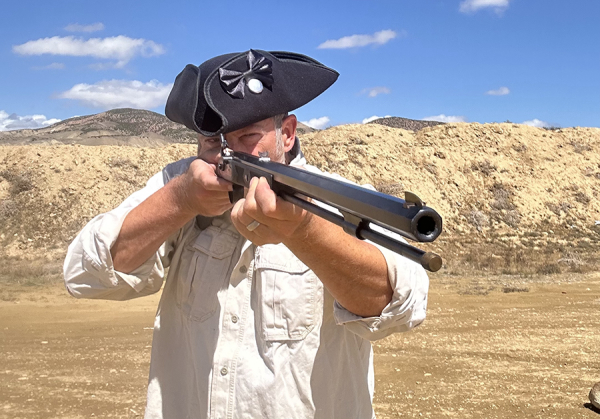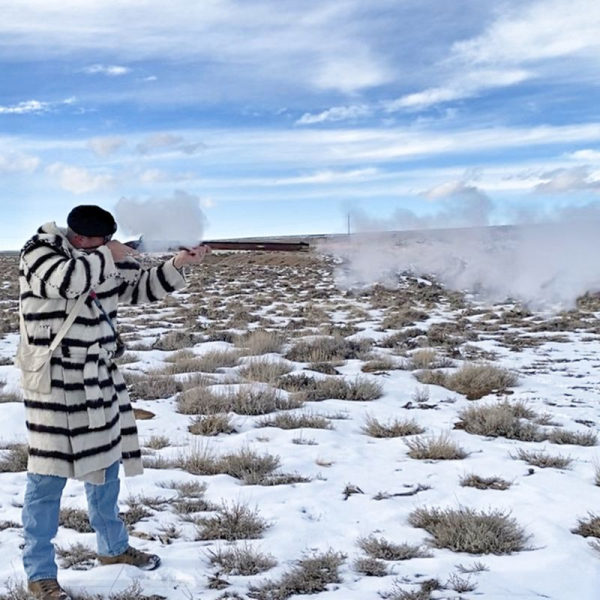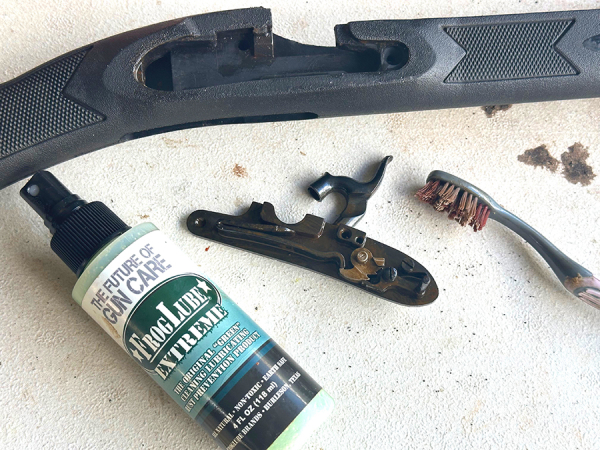Today’s feature comes to us from our companion service, Shooting News Weekly. All images from Paul Markel.

Of all the many fond memories that I have regarding teaching my kids to shoot, our time spent with muzzleloading rifles is near the top. More than two decades ago, I attended a Muzzleloading Instructor course put on by the Ohio 4 H Shooting Sports program and then introduced hundreds of young people to the joys of that shooting discipline, as well as some Living History.
Sadly, it seems like the primary focus for muzzleloading rifles today is on the modernized, inline rifles used primarily for hunting. While that is certainly a noble pursuit, I find it unfortunate that the introductory or entry level muzzleloaders have been left behind.
For those of you who were curious, but thought that muzzleloading was too complicated, I will assure you that it’s not. Your forefathers learned to master the ‘front-stuffer’ and you can too.

Why Should You Shoot a Muzzleloading Rifle?
There are several good reasons why you might be attracted to shooting a muzzleloader. One of the first recommendations for a black powder rifle is gaining a historical appreciation for what our ancestors used. It’s hard to truly understand the importance of the self-contained cartridge until you consider that for hundreds of years, the best method we had was the muzzleloading rifle or musket.
Many experienced adults will begin muzzleloading because it’s a way to extend their annual hunting season. In most, if not all, states, there are designated muzzleloader only or primitive weapon hunting seasons. These seasons are set aside just for people who want to use traditional arms. When compared to “gun season,” the woods and fields during muzzleloader season are generally much less crowded.
One more reason to take up muzzleloading is that it’s a lot of fun. Many shooters begin shooting a black powder rifle because it’s a new challenge and it’s definitely something out of the norm.
Where Do I Begin? My First Muzzleloader
When you decide to look into muzzleloading you will find that there are so many options that getting started might seem a bit daunting. Modern muzzleloading rifles come in sidelock or caplock firing, inline primer firing, flintlock and other styles. Step number one; understand that “lock” refers to the firing mechanism.
A Caplock
My recommendation as someone who has been teaching the use of these firearms for decades is to find yourself a solid .50 caliber, caplock muzzleloader rifle.
A caplock gun uses a primer cap that’s fitted over an offset nipple. The #11 percussion cap is the most common size. The hammer strikes the primer cap which sends a spark through the nipple and into the barrel, igniting the main powder charge.
When I started my muzzleloading journey, numerous manufacturers produced .50 caliber caplock rifles. Many had polymer stocks to bring down the price and reduce the entry barrier. Sadly, today, the only regularly produced models that I could find come from Traditions Performance Firearms. Their Deerhunter model is just what the doctor ordered.

When my oldest son Jarrad, was 12 years old, his mother and I bought him a “Bobcat” .50 caliber caplock muzzleloader for Christmas. I purchased an identical model for myself. We still enjoy shooting those rifles today and that’s the one featured here.
What do you need to start Muzzleloading?
In addition to the actual muzzleloading rifle, you’ll need some components and accessories. In order to load your gun, you will need a loading rod or ramrod. All muzzleloaders come with a loading rod. I can tell you from about three decades of experience that the rod that comes with the gun will be functional, but not of the best quality.
If you really want to enjoy your shooting experience with a muzzleloading rifle, you will want to spend the money and buy what is called a “range rod.” A range rod is a stout, well-made loading rod that’s threaded to accept a variety of rod accessories. You will also want to pick up a device called a “ball starter” or a “short starter.”. It looks like a wooden ball with a dowel stuck in it.

You will also need balls or bullets of the corresponding size for your gun. You will also need either black powder (FF or FFF) or some type of black powder substitute. Hodgdon Triple 7 and Pyrodex are the most common. You will need a container/powder horn to pour your powder out for measuring.
Additionally, you will need a powder measure designed for muzzleloading, NOT smokeless powder reloading. There’s a difference. If you are shooting round lead balls you will need shooting patches. If you are shooting conical bullets, you will need plastic sabots.
Author’s Note: for beginners, I would go with balls rather than bullets. Bullets are more expensive, plus round lead balls are more authentic and traditional.
Speaking of accessories, you will need a cleaning jag in the corresponding size for your rifle. Of all the modern guns, .50 caliber muzzleloaders are the most popular and prevalent today. Guns in .54 caliber come in next. All other calibers are more specialized.
If you are a beginner, I’d recommend that you stick to .50 caliber guns. The cleaning jag holds a cleaning patch that you must use to scrub the carbon and unburnt powder out of the bore of your rifle. Occasionally, the cleaning patch will come off of the jag and you will need to get it out of the barrel. A device called a “patch worm” or “patch remover” will remove the patch easily.
For a caplock gun, you will want some type of “nipple pick” to clean out the carbon and powder fouling from your nipple. A clogged/blocked nipple hole is often the reason why a caplock rifle fails to fire. Some nipple wrenches come with a nipple pick built in.
Muzzleloaders are dirty guns. That;s true whether you use genuine black powder or some kind of black powder substitute. You absolutely must clean your guns thoroughly after shooting them. Powder and other smoke creating powders are hygroscopic. That means they attract and hold moisture. Powder residue left on steel will attract any available moisture and then we encounter oxidation, better known as rust. It’s easy to see where your cleaning efforts were substandard when you pull your muzzleloader out of the safe after a month and find brown rust spots.
Cleaning and Lubricating

Combining petroleum based oils/lubes and loose powder and percussion caps is a no go. For muzzleloading, you will need non-petroleum lubrication. Twenty-five years ago, I didn’t have access to Froglube, a fantastic non-petroleum product. Today I do. Froglube Extreme lubricant comes in a liquid and a paste. The paste is just what the doctor ordered for lubricating patches and the bore of the gun.

I have used the liquid Froglube on the internal lock mechanism as well. You have to inspect and clean the lock portion of the rifle occasionally or it will get rusty. The great thing about using the Froglube products is the fact that I can use it for both my centerfire guns as well as my muzzleloaders.
How to Load a Muzzleloading Rifle
As the name indicates, a muzzleloading rifle is loaded from the front — the muzzle — to the back or the breech. Let’s keep it simple and assume you are using a .50 caliber caplock muzzleloader. The gun is clean, empty and read to go.
Step One: The gun must be vertical, muzzle pointing up. Measure your powder into a dedicated powder measuring device. NEVER guess or dump powder from your horn/contain straight into the barrel. If you are a new shooter, measure out 50 grains of powder in the measure and pour it down the barrel.
Step Two: Place the ball on top of a lubricated shooting patch on the muzzle. Whack the ball starter with the palm of your hand to push the ball into the bore. Now take the range rod and ram the ball all the way down against the powder.
CAUTION: failure to seat the ball against the powder will leave an air gap. That gap creates a fail point that can cause a barrel to violently crack or rupture.
Step Three: Point the rifle downrange and place a primer cap over the nipple. NOTE: always cap last, not first.
Step Four: Cock the hammer, aim at the target, squeeze the trigger and follow through.
Step Five: Unless the Indians are coming to scalp you, take the time to run a cleaning patch down the bore of your gun before you load another round.
Dealing with a Muzzleloader Misfire
If you have a misfire — that is, the cap goes “pop,” but the gun doesn’t go “boom,” — remember to keep your muzzle pointed down range. There is a difference between a hangfire and a misfire. A hangfire occurs when the cap ignites and there is a perceptible time delay, say a half to a full second before the gun fires.
A misfire is when the cap ignites, but after two to three seconds the gun still hasn’t fired. The main cause of a caplock misfire is a misaligned primer cap. The second most common cause is a blocked or clogged nipple. If the cap snaps (ignites), but the gun fails to fire, hold the muzzle down range for 2 to 3 seconds. Next, with the muzzle still pointed down range, install a fresh cap, ensure it’s seated properly, and attempt to fire again. That should work.
If the gun still fails to fire, you can repeat the above steps, but this time attempt to clean the firing hole in the nipple with a nipple pick before putting a new cap on it. Attempt to fire again. If the gun still does not fire, you probably forgot to put powder in the barrel. Now the fun really begins. Seek the help of an experienced professional.
Parting Shots
As I mentioned earlier, if you’re new to muzzleloaders, keep it simple. A caplock .50 caliber gun is a good way to start. After you’ve gained some experience, you might want to move into flintlocks or even muzzleloading handguns.
Given the current situation with ammunition and firearms in the United States, a muzzleloading gun may be both economical and enjoyable. If you like to shoot and are looking for a challenge, muzzleloading might be a really good fit for you.
— Paul Markel, Associate Editor, the Outdoor Wire Digital Network